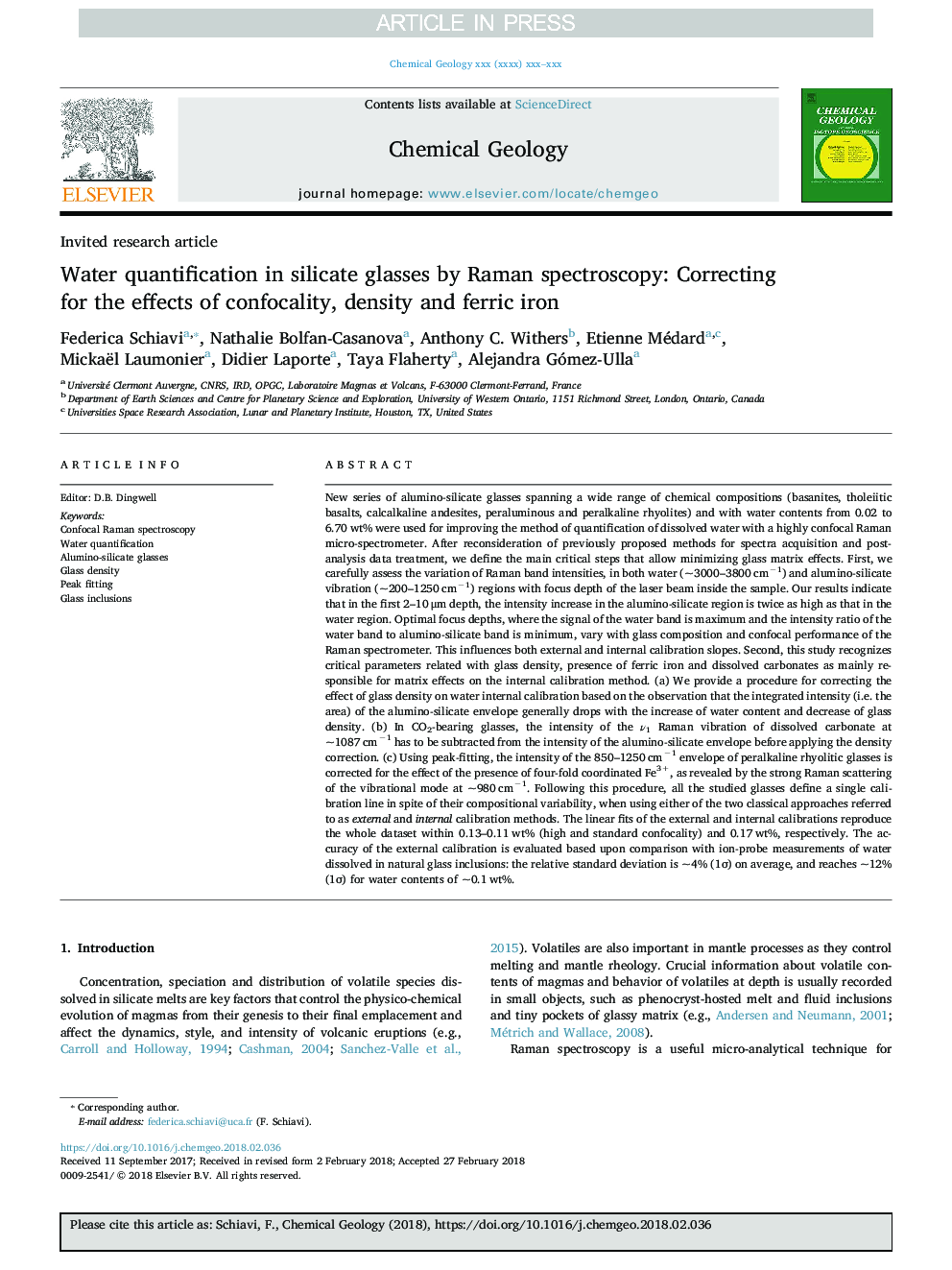| کد مقاله | کد نشریه | سال انتشار | مقاله انگلیسی | نسخه تمام متن |
|---|---|---|---|---|
| 8910291 | 1637491 | 2018 | 20 صفحه PDF | دانلود رایگان |
عنوان انگلیسی مقاله ISI
Water quantification in silicate glasses by Raman spectroscopy: Correcting for the effects of confocality, density and ferric iron
ترجمه فارسی عنوان
کوانتومی آب در عینک های سیلیکات توسط طیف سنجی رامان: تصحیح برای اثرات کنتراست، تراکم و آهن آهن
دانلود مقاله + سفارش ترجمه
دانلود مقاله ISI انگلیسی
رایگان برای ایرانیان
کلمات کلیدی
طیف سنجی کانفوکال رامان، مقدار کافی آب، عینک آلومینیوم سیلیکات، تراکم شیشه، اتصالات قله، درجهای شیشه ای،
موضوعات مرتبط
مهندسی و علوم پایه
علوم زمین و سیارات
ژئوشیمی و پترولوژی
چکیده انگلیسی
New series of alumino-silicate glasses spanning a wide range of chemical compositions (basanites, tholeiitic basalts, calcalkaline andesites, peraluminous and peralkaline rhyolites) and with water contents from 0.02 to 6.70â¯wt% were used for improving the method of quantification of dissolved water with a highly confocal Raman micro-spectrometer. After reconsideration of previously proposed methods for spectra acquisition and post-analysis data treatment, we define the main critical steps that allow minimizing glass matrix effects. First, we carefully assess the variation of Raman band intensities, in both water (~3000-3800â¯cmâ1) and alumino-silicate vibration (~200-1250â¯cmâ1) regions with focus depth of the laser beam inside the sample. Our results indicate that in the first 2-10â¯Î¼m depth, the intensity increase in the alumino-silicate region is twice as high as that in the water region. Optimal focus depths, where the signal of the water band is maximum and the intensity ratio of the water band to alumino-silicate band is minimum, vary with glass composition and confocal performance of the Raman spectrometer. This influences both external and internal calibration slopes. Second, this study recognizes critical parameters related with glass density, presence of ferric iron and dissolved carbonates as mainly responsible for matrix effects on the internal calibration method. (a) We provide a procedure for correcting the effect of glass density on water internal calibration based on the observation that the integrated intensity (i.e. the area) of the alumino-silicate envelope generally drops with the increase of water content and decrease of glass density. (b) In CO2-bearing glasses, the intensity of the ν1 Raman vibration of dissolved carbonate at ~1087â¯cmâ1 has to be subtracted from the intensity of the alumino-silicate envelope before applying the density correction. (c) Using peak-fitting, the intensity of the 850-1250â¯cmâ1 envelope of peralkaline rhyolitic glasses is corrected for the effect of the presence of four-fold coordinated Fe3+, as revealed by the strong Raman scattering of the vibrational mode at ~980â¯cmâ1. Following this procedure, all the studied glasses define a single calibration line in spite of their compositional variability, when using either of the two classical approaches referred to as external and internal calibration methods. The linear fits of the external and internal calibrations reproduce the whole dataset within 0.13-0.11â¯wt% (high and standard confocality) and 0.17â¯wt%, respectively. The accuracy of the external calibration is evaluated based upon comparison with ion-probe measurements of water dissolved in natural glass inclusions: the relative standard deviation is ~4% (1Ï) on average, and reaches ~12% (1Ï) for water contents of ~0.1â¯wt%.
ناشر
Database: Elsevier - ScienceDirect (ساینس دایرکت)
Journal: Chemical Geology - Volume 483, 20 April 2018, Pages 312-331
Journal: Chemical Geology - Volume 483, 20 April 2018, Pages 312-331
نویسندگان
Federica Schiavi, Nathalie Bolfan-Casanova, Anthony C. Withers, Etienne Médard, Mickaël Laumonier, Didier Laporte, Taya Flaherty, Alejandra Gómez-Ulla,
